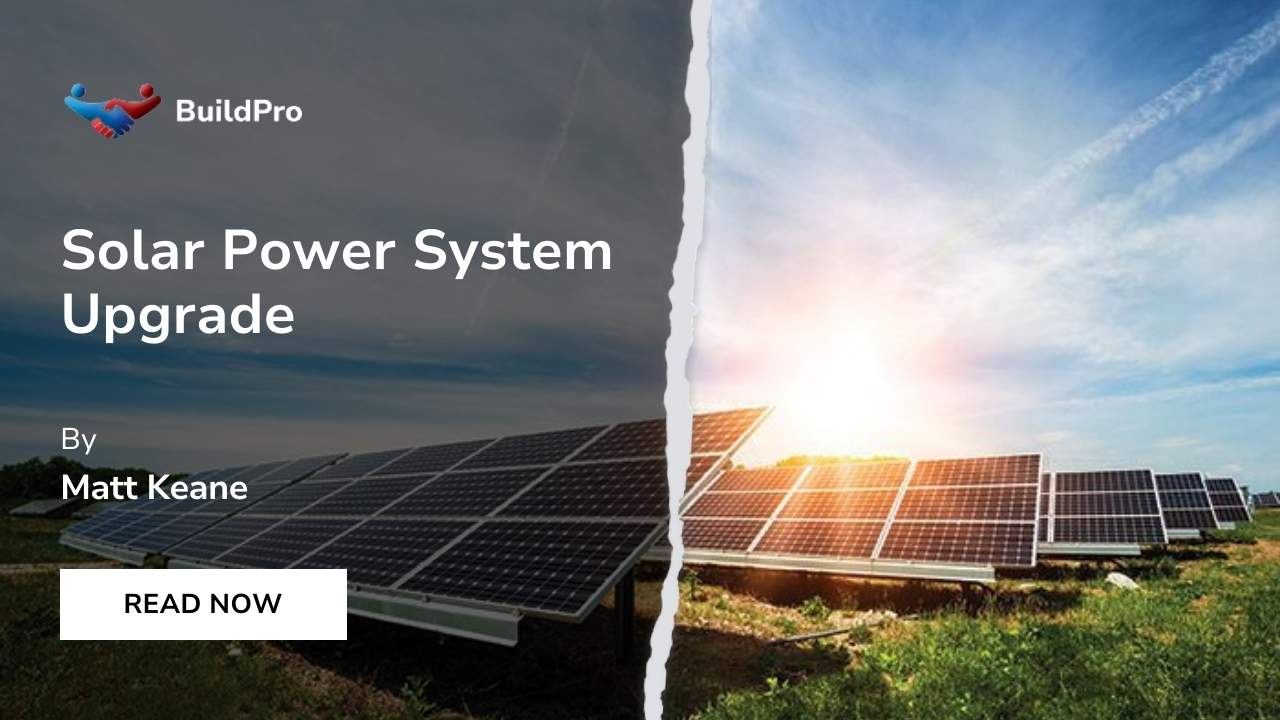Feeling the pinch of escalating electricity costs? You're not alone. We've been there before, witnessing an increase in our energy bills despite having a solar power system installed.
With over 140,000 Irish households generating some or all their electrical needs from solar panels as per a report published by SEAI (Sustainable Energy Authority of Ireland), upgrading your existing setup can be the solution to squeeze more savings and efficiency out of your sun-catching equipment.
In this article, we'll guide you through how to seamlessly upgrade to a bigger solar power system for increased output.
Key Takeaways
- Monitoring and assessing the solar output of your existing system is crucial to determine if upgrading to a bigger solar power system is necessary.
- Increasing the capacity of your system by adding more solar panels, purchasing a new inverter, or incorporating battery storage can boost energy generation and reduce reliance on traditional energy sources.
- To avoid potential issues, it's important to protect feed - in tariffs by understanding state and network provider policies, being cautious of misleading sales tactics, and defining specific needs before proceeding with upgrades.
- When considering DIY upgrades, ensure compatibility between existing and new equipment, properly dispose of old panels, and seek professional assistance if needed.
Assessing the Need for an Upgrade
To determine if upgrading to a bigger solar power system is necessary, homeowners should first check their solar output and assess whether it meets their energy demands.
Checking solar output
Assessing the solar output of your existing system is a crucial first step to upgrading. We advise you to monitor the efficiency and performance of your current panels, as this data serves as a benchmark for any improvements post-upgrade.
By monitoring from day-to-day, season-to-season, you spot trends in energy production that can provide important insights into how well your panels are working. It's also necessary to consider external factors that might influence solar output like shading or dirt build-up on the panels.
If the output doesn't meet expectations or has significantly decreased over time, it may be an indicator it’s time for an upgrade to maintain high efficiency in power generation.
Considering increased energy demand
To meet the growing energy demands of your household, it's important to consider upgrading your solar power system. By increasing the capacity of your system, you can generate more solar electricity and reduce your reliance on traditional energy sources.
Adding more solar panels or upgrading the inverter are effective ways to boost your system's output. Additionally, incorporating battery storage allows you to store excess energy for later use, ensuring a reliable power supply even during periods of low sunlight.
By considering these upgrades, you can support increased energy demand while enjoying greater cost savings and environmental benefits.
Upgrading Options
- Add more solar panels to increase the overall capacity of your solar power system.
- Purchase a new inverter that can handle a larger load and provide better efficiency.
- Incorporate battery storage to store excess energy generated during the day for use at night or during cloudy days.
Adding more solar panels
Adding more solar panels is a great way to upgrade your existing solar power system. It can increase the overall capacity of your system, allowing you to generate more solar energy. This means that you'll be able to power more appliances and devices in your home using clean, renewable energy. Additionally, adding more solar panels can help reduce your reliance on the grid and lower your electricity costs. By investing in additional panels, you'll be able to take advantage of the sun's energy and contribute to a more sustainable future.
Purchasing a new inverter
A new inverter can be a valuable upgrade for your solar power system. It is important to ensure that the inverter you choose has the capacity to handle the increased energy output from additional solar panels. When purchasing a new inverter, consider its efficiency and compatibility with your existing system. Installing a more advanced inverter can improve your solar power system's performance and increase electricity generation. Remember to adhere to state and network provider policies when upgrading your inverter to ensure compliance with standards.
Incorporating battery storage
Adding battery storage to your solar system is a great way to upgrade and enhance its capabilities. With battery storage, you can store excess energy generated by your solar panels during the day and use it during times when there is less sunlight or higher energy demand.
This means that even during cloudy days or at night, you can still power your home with clean, renewable energy. Battery storage also acts as a backup in case of power outages, providing you with uninterrupted electricity supply.
By incorporating battery storage into your solar system, you can maximise your energy independence and reduce reliance on the grid.
Common Mistakes to Avoid
To avoid any potential issues, it is important to protect feed-in tariffs by ensuring that the upgrade complies with state and network provider policies. Additionally, homeowners should be cautious of misleading sales tactics and define their specific needs before proceeding with any upgrades.
Protecting feed-in tariffs
To ensure that you protect your feed-in tariffs when upgrading your solar power system, it is crucial to understand the policies outlined by state and network providers. These tariffs allow homeowners to earn money by selling excess electricity back to the grid.
When making upgrades, such as adding more panels or increasing solar generation capacity, it is important to check if these changes comply with the requirements set by the government for maintaining eligibility for feed-in tariffs.
By staying informed about the rules and regulations surrounding feed-in tariffs, you can maximise your financial benefits from your upgraded solar system. Don't miss out on this opportunity to save even more on your energy costs while contributing towards a greener future!
Avoiding misleading sales tactics
It's crucial to be aware of misleading sales tactics when considering an upgrade to your solar power system. Some salespeople may try to push unnecessary products or upsell you on items that won't actually benefit your system.
To avoid falling victim to these tactics, it's important to do your own research and understand the specific needs of your home before approaching any salesperson. Additionally, take the time to familiarise yourself with state and network provider policies so that you can make informed decisions about what upgrades are necessary and beneficial for your solar system.
Don't let anyone pressure you into making a decision without fully understanding the implications and costs involved. Stay informed, ask questions, and trust your instincts!
Defining specific needs before upgrading
Before upgrading your solar power system, it is essential to define your specific needs. This involves considering factors such as the current output of your solar panels and whether it meets your energy demands.
It's also crucial to assess if an increase in panel capacity or battery storage is necessary to meet future electricity needs. In addition, take into account any state or network provider policies that may affect the upgrade process.
By clearly defining your needs before upgrading, you can ensure that the improvements made will be tailored to meet your unique requirements and provide a more efficient and cost-effective solar power system for years to come.
Considerations for DIY Upgrades
When considering DIY upgrades to your solar power system, it is crucial to ensure compatibility between existing and new equipment. Properly disposing of old panels and seeking professional assistance if needed are also important considerations.
To learn more about these essential aspects of upgrading your solar power system, read on!
Ensuring compatibility of equipment
To ensure a successful upgrade to a bigger solar power system, it is crucial to ensure compatibility of equipment. Here are some key considerations:
- Check the specifications: Before upgrading your solar system, carefully review the specifications of your existing equipment. Ensure that any new components you purchase are compatible in terms of voltage, current, and wiring requirements.
- Consult with professionals: If you are unsure about compatibility or need assistance with the upgrade process, consult with a professional solar installer or technician. They can provide expert guidance and help you choose the right equipment for your specific setup.
- Consider system integration: Upgrading one component of your solar system may require modifications or upgrades to other parts as well. For example, increasing the number of panels may necessitate an upgrade to the inverter or additional battery storage capacity. Take a holistic approach and consider how all components will work together efficiently.
- Future-proofing: When upgrading your solar system, it's wise to think about potential future upgrades or expansions. Choose equipment that allows for scalability and can accommodate any future changes or additions you may want to make.
- Warranty considerations: Before purchasing new equipment for your solar system upgrade, check the warranty terms and conditions. Ensure that adding new components does not void any warranties on existing equipment.
Properly disposing of old panels
When upgrading your solar power system, it is important to properly dispose of old panels. Here's how:
- Research local recycling options for solar panels.
- Contact your solar panel installer for guidance on disposal.
- Consider donating old panels to organisations that can repurpose them.
- If needed, hire a professional to handle the disposal process.
- Ensure that any hazardous materials are safely handled and disposed of according to regulations.
- Document the disposal process for future reference.
Seeking professional assistance if needed
We understand that upgrading your solar power system can be a complex task, and sometimes it's best to seek professional assistance. They have the knowledge and expertise to guide you through the process and ensure that the upgrades are done correctly.
Professional installers can help assess your energy needs, recommend the most suitable upgrades for your home, and ensure that all installations meet industry standards and compliance regulations.
In addition, seeking professional assistance can provide peace of mind knowing that your solar system is being handled by experts who have experience in dealing with various types of systems.
Conclusion
In conclusion, upgrading to a bigger solar power system can bring numerous benefits, including increased energy generation and reduced electricity costs. By assessing your need for an upgrade, considering the available options, and avoiding common mistakes, you can successfully enhance your solar system's performance.
Whether you choose to add more panels or upgrade your inverter, it is important to ensure compatibility and seek professional assistance if needed. With the right upgrades in place, you can enjoy a more sustainable future while saving money on your energy bills.
















